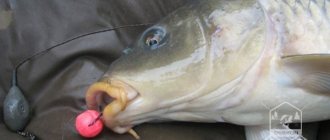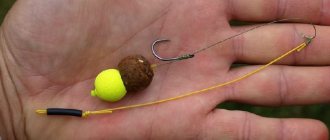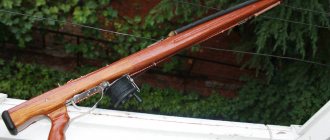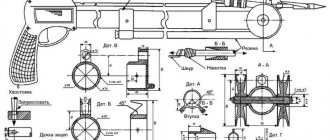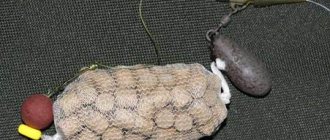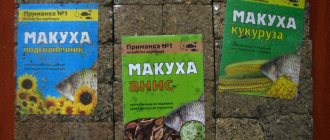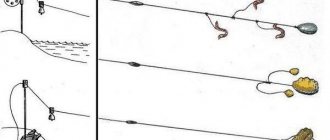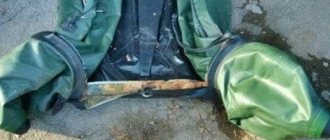Currently, boilies have become almost the most popular and effective bait for catching carp.
Numerous companies are engaged in their production, so you can buy such attachments without any difficulties.
However, it’s even better to make good quality baits yourself, saving money and getting absolutely original boilies at your disposal.
Cooking boilies
- Boilies are made quite simply, in several standard steps.
- First you need to thoroughly mix all the dry ingredients in one bowl; We do a similar procedure with eggs and liquid substances.
- Next, combine all the ingredients and mix well again to form a fairly dense and non-sticky dough.
- We pinch off small pieces from the resulting mass, which we roll into the same small sausages (the size depends on what size boilie you need).
- Next, we cut the sausages into small particles, from which we make balls.
- And the last stage is heat treatment.
If you need very durable boilies, the boilies need to be boiled, then dried well and frozen.
To get loose boilies, use the microwave.
For boilie recipes with exact proportions of ingredients, see below!
Stages of preparing boilies for carp fishing
Now that we have figured out what (and why?) we need to start our own boilie production at home, it’s time for practical action. So, let's start in order...
Proper kneading of dough
To prepare the dough correctly, first of all, you need to follow an important rule: “dry to dry, liquid to liquid.” Therefore, in one of the (two) plastic containers, add all the dry ingredients one by one (strictly according to the weight indicated in the recipe), mixing them evenly.
Choosing boilies depending on the time of year
It is known that carp fish species in cold water prefer foods that are rich in protein.

In this regard, it is better to prepare boilies for spring and autumn fishing using fishmeal, birdseed and other components containing protein.
In the summer, such boilies are inappropriate, so you should use baits that contain carbohydrates and smell like fruits or spices.
Board for making boilies
bkuza » Oct 11, 2016
Good afternoon. I want to start making boilies. In this regard, there is a question about equipment. I want to buy a board for rolling out boilies Rolaball Longbase 20mm from Gardner and I don’t know which table to buy for rolling out sausages 14/18mm or 20/22mm?
Those. Board for rolling out boilies Rolaball Longbase 20mm + Table for rolling out dough ROLLING TABLE 14/18mm
Board for rolling out boilies Rolaball Longbase 20mm + Table for rolling out dough ROLLING TABLE 20/22mm
dmitry111 » Oct 11, 2016
Buy a special gun for making sausages. Gardner definitely has it! The kit includes a set of nozzles with different diameters, which is very convenient (in the gun the dough does not dry out from contact with air). If you go too far with the thickness of the sausage, when you ride the board you end up with barrels instead of balls. I love them even more. and not only me)))) One more nuance. Do not think that you will get balls the same as the stated diameter of the board. They will be 1 size larger, especially after they get into the water. This happens because when rolled on a board, the ball is less dense than when rolled out by hand. For example: we roll a 16mm ball on the board, and after boiling and drying it turns out to be the size of an 18mm ball. Another tip: Buy several tables with different boilie diameters. The scooters are not as dense in structure, unlike store-bought boilies. If you trim them, they fall apart much faster, since the top layer created during cooking is damaged. But scooters have their big advantage - they quickly react with water and begin to generate dust and give off aroma. From my experience, untrimmed boilies retained their shape and emitted a smell for at least 22 hours, and if trimmed, they cracked and fell apart within 4-5 hours.
Boilie recipes for carp fishing
Recipe No. 1 (for warm water)
- Bird food (1.5 cups);
- Soy flour (1 cup);
- Sunflower seeds (half a glass);
- Krupchatka (1.5 cups);
- Eggs.
Recipe No. 2 (for warm water)
- Corn flour (1 cup);
- Wheat flour (1 cup);
- Semolina (2 cups);
- Cinnamon or anise (2 tablespoons);
- Eggs.
Recipe No. 3 (for cold water)
- Ground millet or hemp seeds (1 cup);
- Soy flour (2 cups);
- Fish meal (4 cups);
- Krupchatka (1.5 cups);
- Flavoring of your choice;
- Eggs.
Recipe No. 4 (cold water)
- Corn flour (2 cups);
- Fish meal (1.5 cups);
- Soy flour (1 cup);
- Semolina (1 glass);
- Grated sunflower seeds (half a cup);
- Salt (half a glass).
Recipe No. 5 (cold water)
- Ground flour (300 g);
- Crushed fried seeds (100 g);
- Fish meal (200 g);
- Semolina wheat (50 g);
- Corn semolina (50 g);
- Table salt (10 g);
- Sugar (20 g);
- Meat and fish attractant of your choice (30 ml);
- Fish oil (30 ml);
- 10 eggs.
Smells of boilies
The following components can be used as flavorings: chocolate powder, grated seeds of various plants, anise oil, cinnamon, as well as various substances that speed up digestion (betaine, fennel seeds, hemp pulp and others).
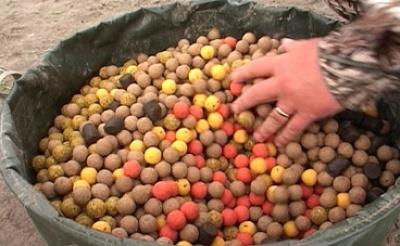
Ready-made dips, attractants, liquids, and special flavors are also used. A variety of sprays and dips are used for external influence on nozzles.
Attractants and liquids are added directly during the preparation of boilies.
Flavors and oils are more often used for bait.
Also read our main article - catching carp with boilies, where you will learn a lot of useful information about the types of boilies, equipment for them, as well as methods for making boilies.
Boilie colors
Color does not play an important role, but carp anglers still advise using yellow, red, and white baits. An important condition is not to use too dark baits in cloudy water.
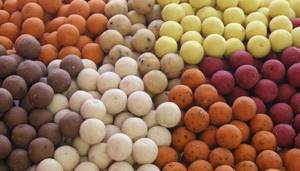
But the main thing when preparing boilies is your own experiments, which will allow you to find the most suitable and effective bait.
Related article: bait boat for fishing
FAQ. Boilie production
We have made a selection of the most popular questions asked by beginning carp anglers regarding the production of boilies. Many people write to us by email, someone asks on social networks in our VKontakte and Facebook groups. We tried to make a FAQ.
Let us immediately make a reservation that for advanced carp anglers such an article may not be of great interest, since the questions raised here are quite trivial. But, if you have your own thoughts on this matter, we are happy to welcome your comments below the news.
Where can I buy the necessary ingredients for the mixes?
Some in regular stores (markets), some in specialized stores with carp nutrition. For example, cereals. This, of course, is purchased in regular grocery stores. Next you need to try to identify the variety, quality, and so on. It is better to buy fishmeal at a carp store. Because it is mostly sold in bulk. If you have the opportunity to purchase fishmeal at retail, then always pay attention to its quality. The fact is that fishmeal is different from fishmeal. It is very important how rich in nutrients it is.
Conclusion: simple things that are regularly used in everyday life can be safely purchased at markets or regular stores. Specialized items are available in specialized carp nutrition stores.
Can I do something myself? For example, buy seeds for canary parrots at a pet store, grind them in a blender and thus get flour from birdseed?
Of course yes! Poultry food manufacturers always use proven products and undergo veterinary control before releasing the product for sale. Therefore, if you grind grains in a blender, you will get excellent bird seed flour.
Conclusion: You can create your own flour by grinding the same birdseed grains. But be very careful with one ingredient. UNDER NO EVENT should you use raw peanuts . It is poisonous to fish. It is always better to fry it first and only then grind it into flour.
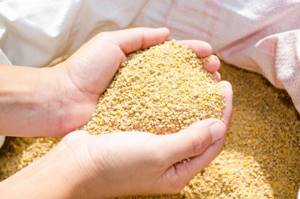
What are the best amino acids to add to your boilies?
In fact, the selection of amino acid complexes and liquids for your own production of boilies is no different from the selection of liquids for bait. The only difference is in the dosages. Since you will be cooking boilies, you need to be aware that at high temperatures most of the beneficial substances will evaporate. Therefore, the average dosage of liquids increases, as a rule, by 3-4 times. Let’s say the same CCMoore liquids, if their portion in the spod mix is 30 ml (on average) per 1 kg, then here this volume should be increased to 100 ml per 1 kg of the base mix.
Conclusion: we are guided by general concepts about amino acids and extracts.

Why freeze boilies after they are dry?
The beauty of scooters is that you don't use preservatives. And therefore freezing is the only possible option to keep them fresh. All that remains for you is to take them out before fishing, put them in a bag and bring them to the pond. Since the boilies will begin to “thaw” after entering a warm environment, they will become covered with moisture. This is why bags for drying boilies were invented. You hang them on a tree and dry them. And in order to refresh, they use the rehydration process.
Conclusion: boilies can be stored in the freezer for a very long time
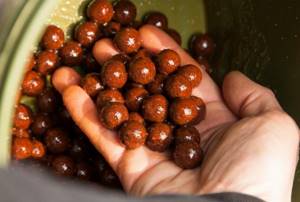
How to properly dry boilies after cooking?
First you need to make sure that it is a well-ventilated area. The boilies will dry better and faster. As soon as the boilies are dry (on average about 48 hours after cooking), they should be frozen, otherwise they will become moldy.
Conclusion: dry boilies to get rid of excess moisture
If I want to change a recipe, where should I start experimenting?
The key here is to always understand the significance of the ingredients you want to replace. For example, you can't replace the binder with something that only adds flavor. It is important to keep the mixture balanced in terms of binders, flavor and ease of digestion by the fish.
To get started, we would recommend that you read our article about building a basic mix. The logic for creating the base mixture is described in detail there. Which substances belong to which class.
Also, to start experimenting, we would recommend that you play with colors and flavors. Even adding a small amount of flavor to an existing mix can give it a different look. You can play with different flavors and see which one gets you a bite first. You can add a few drops of essential oil, which generally increases the attractiveness of any mixture. Being natural, these oils are easily digested by carp.
Conclusion: for more understanding, read the article!
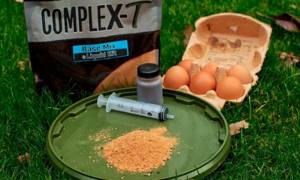
Equipment for rolling boilies is quite expensive. Is it possible to do without it?
In fact, to make boilies for yourself in the kitchen, you don’t have to buy fancy equipment. The only problem you'll have in the absence of a sausage gun or rolling board is time. It’s just that the process of preparing boilies will take longer than with these accessories.
Also, you are unlikely to be able to roll the boilies perfectly to the same diameter. This is fraught with the fact that difficulties may arise when feeding from a cobra. If you don't use cobra, then there shouldn't be any problems.
For those who are going to roll boilies manually, here is a little advice on how to speed up the process:
- Cut your dough as shown in the photo. The result will be something like sausages, only they will be in the shape of a parallelepiped.
- Then we begin to cut perpendicular to the longitudinal cuts. And here is the main trick. If we roughly cut cubes 2x2cm, then when we roll out with our palms, we will get approximately a 20mm boilie.
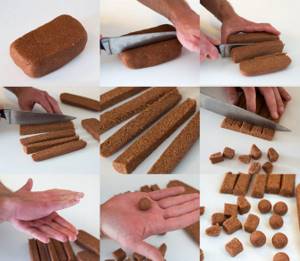
- How to Create Your Own Basic Mix
- How to roll boilies and not go wrong
Full or partial copying without the consent of the portal editors is prohibited
